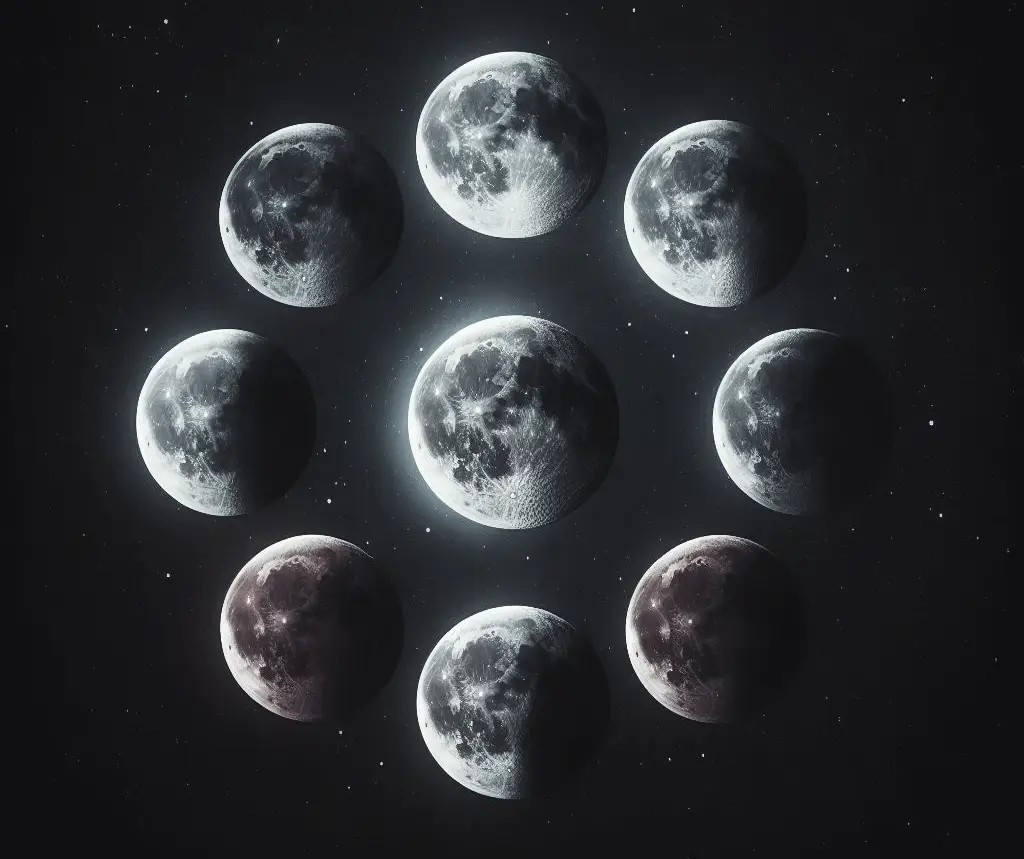Welcome to our insightful journey through the Moon Phases in Astrology. The moon, a celestial body that has captivated humanity for millennia, plays a pivotal role in astrology, influencing our emotions, behaviors, and spiritual practices. From the potent New Moon to the illuminating Full Moon, each phase holds unique energies and implications. In this article, we’ll uncover the significance of these lunar cycles and how they intricately weave into our lives. Whether you’re an astrology enthusiast or a curious learner, join us in unraveling the mysteries of the moon and its profound astrological influence.

Moon Phases and Astrology
Astrology offers a unique lens to view our lives. Central to this cosmic dance is the Moon, influencing our emotions and experiences. In astrology, the Moon’s phases reflect different stages of our journey, each with its distinct energy and influence.
The Significance of the Moon Phases in Astrological Practices
In astrology, the Moon acts as a mirror, reflecting our deepest needs and desires. It governs our emotional landscape. For instance, during the Full Moon, feelings are heightened. People may feel more intense emotions. This is especially true for water signs like Cancer, Scorpio, and Pisces, known for their emotional depth. Conversely, signs like Gemini and Aquarius might find these periods challenging, as they often prefer logic over emotion. The Moon’s position in our birth chart reveals much about our instinctual reactions and inner self. It’s a powerful tool for self-understanding.
Overview of the Moon’s Phases
Each lunar phase brings a unique energy. The New Moon, symbolizing new beginnings, is a time for setting intentions. It’s a period where signs like Aries and Leo thrive, as they’re all about initiation and taking bold steps. During the Waxing Moon, we build and take action, a phase where steadfast signs like Taurus and Capricorn find their groove. The Full Moon, a time of culmination and release, resonates with transformative signs like Scorpio and Virgo. They excel in harnessing this energy for personal growth. Finally, the Waning Moon encourages reflection, a period where introspective signs like Pisces and Cancer delve deep into their inner worlds.

The New Moon: Beginnings and Intentions
The New Moon marks a time of renewal and potential. It’s a blank slate in the lunar cycle. This phase invites us to set intentions and start fresh, offering a unique opportunity for self-reflection and goal setting.
Astrological Significance of the New Moon
Astrologically, the New Moon is a powerful moment for planting seeds of change. Each New Moon occurs in a different zodiac sign, coloring our intentions with that sign’s qualities. For example, a New Moon in Aries sparks initiatives and courage, while in Taurus, it encourages us to focus on stability and pleasure. This phase is ideal for introspection. It allows us to align our desires with the universe’s rhythms. Signs like Leo and Sagittarius, known for their forward-thinking and adventurous spirit, find this phase particularly invigorating.
Setting Intentions and New Moon Rituals
Creating a New Moon ritual can be a transformative practice. It’s about more than just making a wish. It involves grounding yourself, meditating, and setting clear, achievable goals. Writing down intentions is a common practice. It helps manifest desires into reality. For signs like Virgo and Capricorn, this structured approach resonates strongly. Incorporating elements like crystals or essential oils, aligned with the specific zodiac sign of the New Moon, can enhance the ritual. Water signs like Cancer and Pisces might prefer rituals that involve emotional release, like journaling or water-based practices.
The Waxing Moon: Building and Taking Action
The Waxing Moon phase is a time of momentum and progress. As the moon grows fuller, it symbolizes building energy and potential. This phase encourages tangible steps towards our goals.
Growth and Opportunities in the Waxing Moon Phase
During the Waxing Moon, the energy shifts from introspection to action. It’s a period ripe for growth and advancement. For earth signs like Taurus, Virgo, and Capricorn, this phase aligns with their natural tendency towards persistence and hard work. It’s an excellent time to focus on personal development and career goals. Air signs, like Gemini, Libra, and Aquarius, can use this energy to advance their social and intellectual pursuits. The waxing phase supports expansion in all forms, be it personal, professional, or spiritual.
The Waxing Moon Phase
Navigating the Waxing Moon effectively involves harnessing its dynamic energy. It’s crucial to stay focused and not get overwhelmed by the increasing pace. Fire signs like Aries, Leo, and Sagittarius, thrive under this active energy, often taking bold steps. However, they must remember to balance enthusiasm with practicality. Water signs, such as Cancer, Scorpio, and Pisces, might need to push against their comfort zones during this phase. Staying grounded and setting realistic milestones can help in making the most of this time. Activities like creating a task list or a vision board can be particularly effective during the Waxing Moon.
The Full Moon – Moon Phases
The Full Moon is a phase of completion and illumination. It brings to light the results of efforts started during the New Moon. This is a time for reflection, celebration, and sometimes, letting go.
Impact of the Full Moon in Astrology
Astrologically, the Full Moon is significant. It often brings clarity and revelations. Emotions are heightened, and situations reach a peak. This phase can particularly affect water signs like Cancer, Scorpio, and Pisces, intensifying their emotional depth. For air signs such as Gemini, Libra, and Aquarius, the Full Moon can bring mental clarity, making it an ideal time for decision-making. Each Full Moon aligns with the zodiac sign opposite to the Sun, creating a balance of energies. For example, a Full Moon in bold Aries contrasts with the Sun in harmonious Libra, highlighting the balance between self and relationships.
Full Moon Rituals for Release and Celebration
Full Moon rituals often focus on release and gratitude. It’s a time to let go of what no longer serves us. Rituals can include meditation, writing down things to release, and even small gatherings to celebrate achievements. Earth signs like Taurus, Virgo, and Capricorn can benefit from grounding rituals, such as walking in nature or gardening. Fire signs, Aries, Leo, and Sagittarius, might prefer more active rituals, like dancing or energetic cleansing practices. Incorporating elements like moon water or charged crystals can enhance the ritual, aligning with the Full Moon’s energy.
The Waning Moon: Reflection and Letting Go
The Waning Moon phase signals a time to slow down and reflect. It’s a period for introspection and assessing what we need to release. This phase helps us prepare for the rebirth of the New Moon.
Moon Phases in the Waning Phase for Inner Work
The Waning Moon is ideal for inner work and self-analysis. It’s a time to contemplate our achievements and challenges. Water signs, like Cancer, Scorpio, and Pisces, naturally resonate with this introspective energy. They can use this time for deep emotional healing and clearing past traumas. Earth signs, Taurus, Virgo, and Capricorn, might focus on practical aspects of their lives, evaluating and reorganizing their goals. This phase encourages all signs to slow down, breathe, and realign with their true paths.
Astrological Guidance for the Waning Moon Period
During the Waning Moon, it’s beneficial to practice letting go. Release rituals can be simple but powerful. They might include writing down fears or doubts and safely burning the paper. Air signs, such as Gemini, Libra, and Aquarius, can benefit from mental decluttering, perhaps through meditation or journaling. Fire signs, like Aries, Leo, and Sagittarius, might find physical activities like yoga or long walks helpful in releasing pent-up energy. This period is a reminder that endings are just as important as beginnings in the cycle of growth and renewal.
Integrating Moon Phases in Daily Life
Understanding and integrating the moon phases into daily life can enhance our connection to the natural world and our inner selves. It’s a way to align with cosmic rhythms and use them to support our personal growth.
Moon Phases with the Lunar Cycle
Aligning with the lunar cycle involves mindfulness and observation. Start by tracking the moon phases and noticing how you feel during each phase. You might find that your energy levels or moods correlate with certain phases. For example, you may feel more energetic during the Waxing Moon and more reflective during the Waning Moon. Use these insights to plan activities: initiate projects during the New Moon, take action during the Waxing Moon, celebrate achievements at the Full Moon, and let go of unnecessary burdens during the Waning Moon. Air signs like Gemini, Libra, and Aquarius can use this knowledge to optimize their social and intellectual endeavors, while earth signs like Taurus, Virgo, and Capricorn might focus on practical and career-related planning.
Moon Phase Calendars and Astrology
Using a moon phase calendar is a practical way to stay in tune with the lunar cycle. These calendars not only show the phases but often include astrological information, like which sign the moon is in. This can be particularly useful for planning activities or understanding emotional shifts. For instance, a moon in a water sign might indicate a time for emotional work, while a moon in a fire sign could signal a period of high energy and creativity. Additionally, consider incorporating astrology into your daily routine by reading lunar forecasts or consulting with an astrologer. This can provide deeper insights into how the moon phases interact with your personal astrological chart, offering guidance tailored to your unique path.
Did You Know?
- Lunar Effect on Behavior: The belief that the full moon influences human behavior dates back centuries. While scientific studies offer mixed results, many cultures hold strong traditions linking the full moon with enhanced creativity or heightened emotional states.
- Moon Gardening: Some gardeners swear by the lunar cycle for planting. They believe that the moon’s gravitational pull affects soil moisture, making certain phases better for planting and growth.
- Ancient Lunar Calendars: The lunar cycle has been used to measure time since ancient civilizations. The Roman calendar, for instance, was originally lunar-based, with months aligning to the moon’s phases.
Myths and Facts
- Myth: Full moons cause lunacy and erratic behavior.
- Fact: There’s no scientific evidence proving a direct link between the full moon and human behavior, though the myth persists in popular culture.
- Myth: The moon’s phases can influence physical health.
- Fact: While the moon’s gravitational pull does affect tides, there’s no concrete evidence that it has a significant impact on human health.
- Myth: You can balance an egg on its end only during the spring equinox. Fact: The idea that this is possible due to gravitational changes is a myth. With patience, you can balance an egg on its end on any day of the year.
Moon Phases FAQ
- How many moon phases are there?
There are eight distinct phases of the moon in a complete cycle. These are the New Moon, Waxing Crescent, First Quarter, Waxing Gibbous, Full Moon, Waning Gibbous, Last Quarter, and Waning Crescent. - What are the phases of the moon?
The moon phases include the New Moon, Waxing Crescent, First Quarter, Waxing Gibbous, Full Moon, Waning Gibbous, Last Quarter, and Waning Crescent. Each phase represents the moon’s position in relation to the Earth and Sun. - What causes the phases of the moon?
The moon phases are caused by the moon’s orbit around Earth, changing the portion of the moon illuminated by the Sun that we can see from Earth. - Why does the moon have phases?
The moon has phases because of its orbit around Earth. As it orbits, different parts of the moon are lit up by the Sun, creating the phases we see. - What causes moon phases?
The moon phases are caused by the moon’s position relative to Earth and the Sun. As the moon orbits Earth, sunlight illuminates different parts of the moon’s surface, creating the phases. - Why do we see moon phases?
We see moon phases because of the moon’s orbit around Earth. The changing angles between the Earth, moon, and Sun result in varying amounts of the moon’s surface being illuminated, which we observe as different phases. - What does ‘waxing’ mean in moon phases?
‘Waxing’ refers to the period when the illuminated part of the moon is increasing, from New Moon to Full Moon. It signifies growth and expansion in lunar terms. - How many phases does the moon have?
The moon has eight distinct phases in its cycle: New Moon, Waxing Crescent, First Quarter, Waxing Gibbous, Full Moon, Waning Gibbous, Last Quarter, and Waning Crescent.
Read also: Your Comprehensive Gemini Horoscope 2024: A Year of Cosmic Insights





